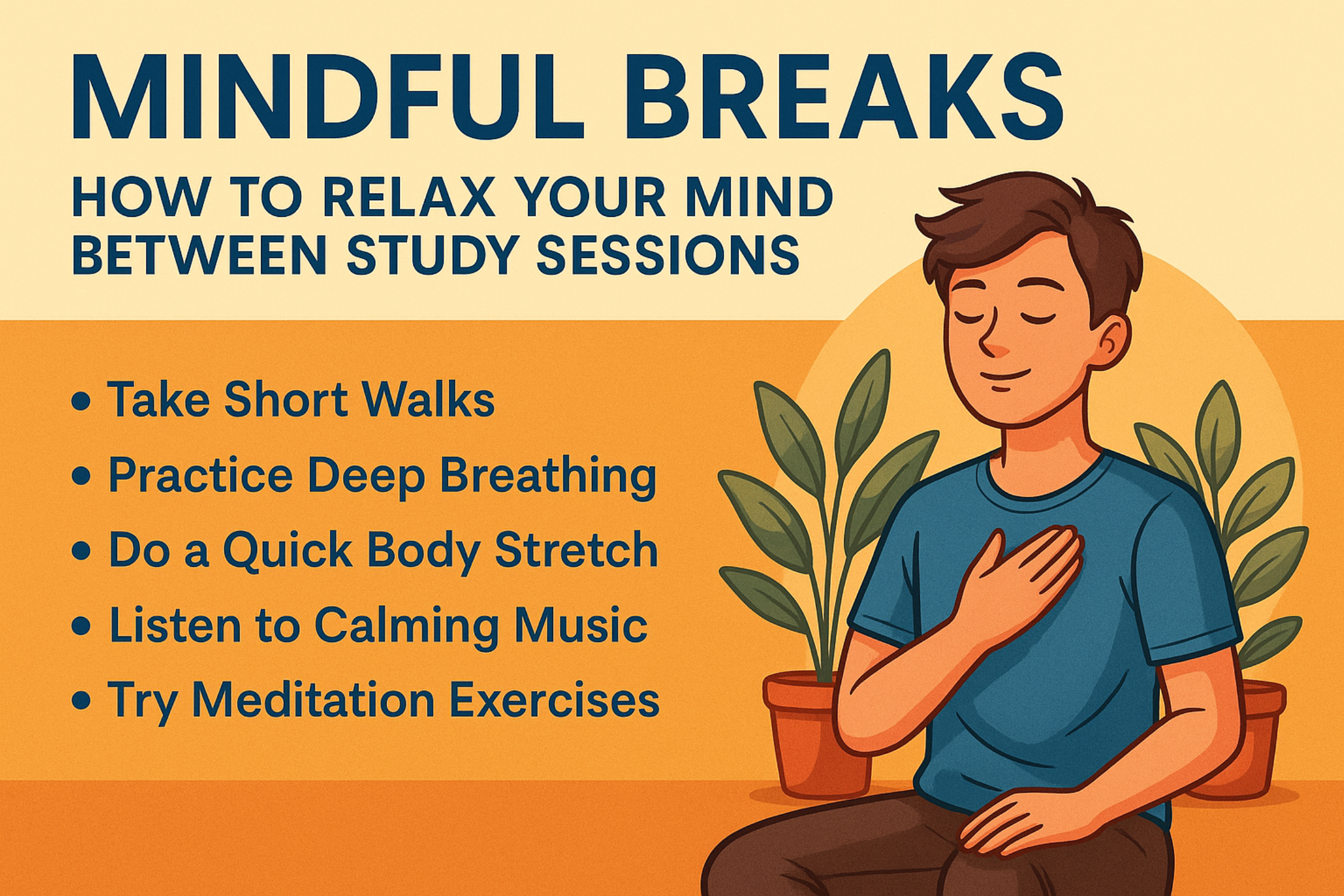Studying for long hours without meaningful breaks can leave you feeling drained, stressed, and even less productive. While it may seem that pushing through study sessions without stopping is the best way to get more done, studies show that taking mindful breaks actually improves focus, retention, and mental well-being.
In this blog, we’ll explore why mindful breaks are essential, what they mean, and how students can easily include them in their study routines for better results.
Why Mindful Breaks Matter
Our brains are not designed for continuous concentration for hours. When we push ourselves too long without a break, mental fatigue sets in, making it harder to retain information and stay focused.
Benefits of mindful breaks:
- Improve concentration and memory
- Reduce stress and anxiety
- Boost creativity and problem-solving skills
- Prevent burnout
- Support emotional and mental health
Mindful breaks are not just about stopping work; they are about intentionally allowing your mind to rest, recharge, and regain energy.
What Is a Mindful Break?
A mindful break is a short, intentional period where you stop your study session and focus completely on relaxation and being present. Unlike passive breaks where you scroll through social media or watch videos, mindful breaks involve purposeful activities that calm your mind and body.
It’s about giving full attention to the moment—whether it’s through breathing, stretching, walking, or quietly observing your surroundings.
How Often Should You Take a Break?
While it varies from person to person, a good guideline is to take a 5–10-minute mindful break after every 45–60 minutes of focused study.
Look out for signs that it’s time for a break:
- Difficulty concentrating
- Eye strain or fatigue
- Feeling restless or bored
- Daydreaming or zoning out
Taking regular mindful breaks can prevent exhaustion and help you stay productive for longer periods.
Simple Mindful Break Activities
Here are some easy, relaxing activities you can try during your breaks:
1. Deep Breathing
Sit comfortably, close your eyes, and take slow, deep breaths. Focus on the sound and feel of your breath. Deep breathing lowers your heart rate and helps clear your mind.
2. Stretching
Stand up and stretch your arms, back, and legs. Gentle stretches improve blood circulation and relieve the stiffness caused by sitting for long periods.
3. Short Walk
Step outside if you can, or walk around your room slowly and mindfully. Pay attention to how your feet feel touching the ground. A short walk helps reset your brain.
4. Listen to Calming Sounds
Listen to soft instrumental music, nature sounds like rain or birds, or even the simple sounds around you. This calms your nervous system and refreshes your focus.
5. Mindfulness Moments
Practice simple mindfulness exercises like observing five things you can see, four you can touch, three you can hear, two you can smell, and one you can taste. This grounds you in the present moment.
6. Drinking Water or Healthy Snacking
Stay hydrated and energized by sipping water or eating a light, healthy snack. Avoid heavy meals that can make you feel sluggish.
7. Quick Creative Activities
Spend a few minutes doodling, scribbling, or writing a few thoughts in a journal. Creative activities allow your mind to wander in a positive and healthy way.
How to Build Mindful Breaks into Your Study Routine
Making mindful breaks a habit can be easy if you set a structure:
- Use a Timer: Study for a set amount of time, then take a short mindful break when the timer goes off.
- Prepare in Advance: Before studying, decide what type of mindful activity you’ll do during breaks.
- Designate a Break Space: Have a corner with a comfortable chair, soft lighting, or even a plant where you can retreat for your break.
- Stay Away from Screens: Avoid using your phone, tablet, or TV during mindful breaks. Let your mind fully relax.
Mindful Breaks vs Regular Breaks
While any break is better than none, mindful breaks are more beneficial because they involve intentional relaxation rather than mindless activities. Passive scrolling or watching videos can overstimulate your brain, making you feel even more tired afterward.
Mindful breaks, in contrast, refresh your mental energy naturally and help you return to studying with renewed focus.
Benefits Over Time
Incorporating mindful breaks into your daily study routine doesn’t just improve study sessions—it also builds resilience, emotional regulation, and self-awareness over time.
You will notice:
- Less frustration and anxiety during intense study periods
- More enjoyment and satisfaction in your work
- Better sleep and overall mood
- Stronger learning habits that benefit you long-term
Final Thoughts
Being productive isn’t about studying longer—it’s about studying smarter. Mindful breaks are a simple, powerful tool to enhance your learning journey.
Next time you sit down for a study session, remember to plan your breaks thoughtfully. Treat your mind kindly, and it will reward you with better focus, better memory, and a much better experience overall.
Taking just a few moments to breathe, stretch, and relax might be the secret to achieving your best academic performance yet!




